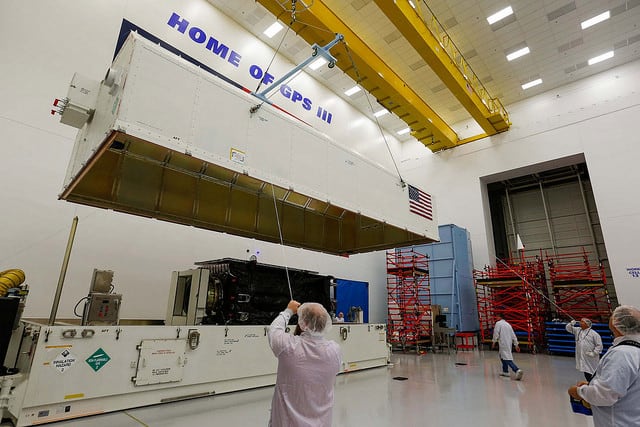
The first of a new generation of Global Positioning Systems satellites built by Lockheed Martin for the U.S. Air Force is “talking” with engineers and operators after a successful launch over the weekend.
The GPS III satellite, built at Lockheed Martin’s facility in Jefferson County, lifted off Sunday morning aboard a SpaceX Falcon 9 rocket. The launch was originally scheduled Dec.18 but severe weather and unspecified issues with sensor readings on the rocket’s first stage delayed the takeoff.
Lockheed Martin said the GPS III Space Vehicle 01 was receiving and responding to commands from the company’s launch and checkout center Sunday. Air Force and company engineers announced the satellite had separated from the booster rocket and signals were being received 119 minutes after launch.
It’s been an eventful couple of months for Lockheed Martin’s crew in Jefferson County. The company built NASA’s lander InSight, which landed on Mars Nov. 26. And a spacecraft designed and built by Lockheed Martin Space Systems reached its destination Dec. 3 in the first U.S. attempt to collect samples from an asteroid and bring them back to Earth.
Centennial-based United Launch Alliance launched both spacecrafts.
The latest craft making news, the GPS III SV01, is the first of a new generation of satellites designed to modernize the GPS constellation, Lockheed Martin said. The GPS III is three times more accurate and up to eight times harder to jam than the satellites in the constellation now.
“In the coming days, GPS III SV01 will use its liquid apogee engines to climb into its operational orbit about 12,550 miles above the Earth. We will then send it commands to deploy its solar arrays and antennas, and begin on-orbit checkout and tests, including extensive signals testing with our advanced navigation payload provided by Harris Corporation,” Johnathon Caldwell, Lockheed Martin’s vice president for navigation systems, said in a statement.
Although best-known for widespread civilian applications, GPS was developed by the U.S. military, which still designs, launches and operates the system. The Air Force controls a constellation of 31 GPS satellites from a high-security complex at Schriever Air Force Base outside Colorado Springs, according to The Associated Press.
Lockheed Martin delivered the GPS III satellite to Florida on Aug. 20. Once declared operational, GPS III SV01 is expected to take its place in the existing satellite constellation, which provides positioning, navigation and timing services to more than 4 billion civil, commercial and military users.
The Air Force nicknamed the satellite “Vespucci” after Italian explorer Amerigo Vespucci.
“By this time next year, we expect to also have a second GPS III (in) orbit and users should be receiving signals from this first satellite,” Caldwell said.
The satellite launched Sunday is the first of 10 GPS III satellites originally ordered by the Air Force. Lockheed Martin said the Air Force has called for the second satellite to be launched in 2019. Satellites three through eight are in various stages of assembly and testing.
In September, the Air Force selected Lockheed Martin for the GPS III Follow On program, an estimated $7.2 billion opportunity to build up to 22 additional satellites with additional capabilities. The company said it is under contract to build up to 12 GPS III satellites.























